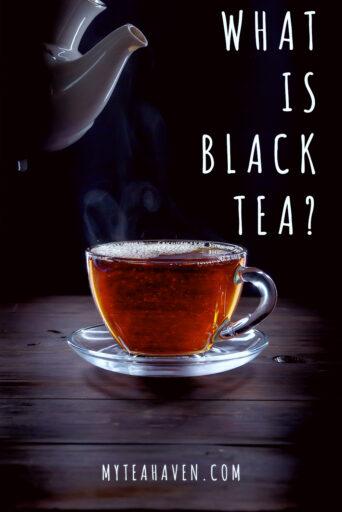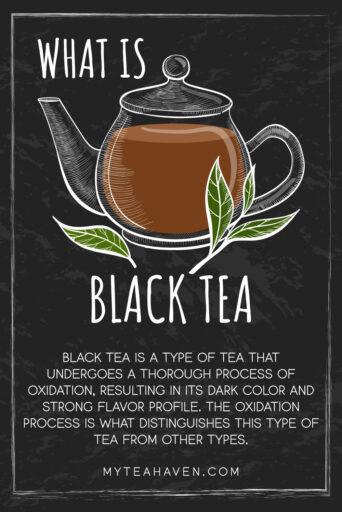What is Black Tea? Unraveling the Secrets of this Captivating Brew
What is Black Tea
It’s time to talk about one of the most popular and beloved types of tea: black tea. Today we’ll uncover what it is, how it’s produced, and what sets it apart from other teas. So, grab a cup of your favorite tea and let’s embark on this delightful dark journey!
We are a participant in the Amazon Services LLC Associates Program, an affiliate advertising program designed to provide a means for us to earn fees by linking to Amazon.com and related sites. This post may contain affiliate links which means we may receive a commission, at no cost to you, for purchases made using our links. Please see my disclosure to learn more. Unless otherwise stated, all prices are in US$.
Introduction
Tea has been an integral part of many different cultures around the world for centuries. Black tea has a special place in the hearts of tea lovers due to its robust flavor and distinctive characteristics.
This tea originates from the Camellia sinensis plant, but it undergoes a unique process of production that sets it apart from its green, oolong, and white counterparts.
What is Black Tea?
Black tea is a type of tea that undergoes a thorough process of oxidation, resulting in its dark color and strong flavor profile. The oxidation process is what distinguishes this type of tea from other types.

When tea leaves are exposed to oxygen, enzymes present in the leaves react with the air. This process causes the leaves to turn dark and develop their unique flavor.
How is Black Tea Produced?
The production of black tea involves several crucial steps that contribute to its characteristic taste and appearance. Let’s take a closer look at how it’s produced.
Cultivation and Harvesting of Tea Leaves

Black tea is primarily cultivated in countries like India, China, Sri Lanka, and Kenya. The tea plants thrive in warm and humid climates, with specific regions known for their exceptional tea-growing conditions.
The top leaves and buds of the tea plant are carefully plucked by skilled tea harvesters, ensuring the finest quality for further processing.
Oxidation Process
Once the tea leaves are harvested, they undergo a process called oxidation. This process involves allowing the leaves to wither and naturally react with the oxygen in the air.
During oxidation, the enzymes present in the tea leaves trigger a series of chemical reactions. This then leads to the conversion of green tea leaves into the characteristic black tea leaves.
Drying and Fermentation
After the desired level of oxidation is achieved, the tea leaves are dried to halt the oxidation process. This step is crucial in preserving the flavor and aroma of the black tea.
Drying may be done using different methods, such as air drying or roasting. It mostly depends on the desired outcome. The dried tea leaves are then sorted and graded based on their size and quality.
Varieties of Black Tea
The world of black tea offers a vast array of flavors and nuances, each with its own distinct characteristics. Here are some popular varieties:
Assam Tea
Originating from the Assam region in India, Assam tea is known for its rich, malty flavor and robust aroma. It is often used as a base for breakfast teas due to its strong character.

VAHDAM, Assam Black Tea Leaves
A High Caffeine Full-Bodied Whole Leaves. Sweet Flavor With Hints Of Malty Nuttiness With Wafting Hues Of Caramelised Nuts And Raisins. A Dash Of Milk And Sugar Makes For A Good Breakfast Tea To Kickstart Your Mornings, Best Served As Straight Black Tea Or As Milk Tea.
Darjeeling Tea
Hailing from the picturesque Darjeeling region of India, Darjeeling tea is celebrated for its delicate flavor and floral notes. Referred to as the “Champagne of Teas,” it is highly sought after by tea connoisseurs.
Ceylon Tea
Sri Lanka, formerly known as Ceylon, produces the exquisite Ceylon tea. These teas possess a bright and lively flavor profile, ranging from light and delicate to bold and full-bodied.
Earl Grey Tea
Infused with the aromatic essence of bergamot, Earl Grey tea offers a delightful twist to traditional black tea. It exudes a citrusy fragrance and a distinctive, refreshing taste that captivates tea lovers worldwide.

VAHDAM, Earl Grey Tea Bags
This aromatic blend of high quality, garden-fresh black tea with 100% natural oil of bergamot can be brewed hot, iced or as kombucha tea.
English Breakfast Tea
A classic blend that has become a staple in many households, English Breakfast tea is a robust and invigorating blend. It’s perfect for kick-starting your day with a burst of energy!
Brewing and Serving Your Tea
To fully appreciate the flavors and aromas of black tea, it is essential to brew and serve it correctly. Here are some tips to ensure the perfect cup:
Water Temperature and Steeping Time
The ideal water temperature for brewing black tea is around 195 to 205 degrees Fahrenheit (90 to 96 degrees Celsius). Steep the tea leaves for 3 to 5 minutes, or follow the instructions provided on the tea packaging. Avoid oversteeping your tea, as it can result in a bitter taste.
Proper Teapot and Tea Cup
Choose a teapot made of ceramic or glass to retain heat efficiently. The teapot should have enough space for the tea leaves to unfurl and release their flavors. When serving, opt for porcelain or ceramic tea cups to preserve the tea’s temperature.

STNTUS Glass Teapot with Infuser for Loose Tea
Say goodbye to water splashing as this teapot spout is designed to prevent any splashes. Moreover, the handle has been widened and thickened, making it more user-friendly and ensuring your safety. This versatile teapot is perfect for making a wide array of beverages including tea, coffee, and herbal infusions. With its removable filter, cleaning has never been easier. Simply remove the filter and give it a quick clean, making the entire process more convenient and hassle-free.
Adding Milk or Sugar
Black tea can be enjoyed plain or with a dash of milk and a sweetener of your choice, such as sugar or honey. The addition of milk gives it a creamy and a more mellow taste, while sugar can enhance its natural sweetness. Experiment to find your preferred combination!
Tips for Choosing and Buying
With so many options available, selecting high-quality black tea can be overwhelming. Consider the following tips when choosing and buying:
Quality and Freshness
Look for black teas made from whole leaves, as they generally offer a more nuanced and flavorful experience compared to tea bags. Choose teas that are packaged in airtight containers or resealable bags to ensure freshness.
Loose Leaf vs. Tea Bags
While tea bags offer convenience, loose leaf provides a superior taste and aroma.
Loose leaf tea allows the leaves to expand fully during brewing, releasing their flavors more effectively. Invest in a tea infuser or a tea strainer to enjoy the benefits of loose leaf.

Buying from Reputable Sources
Purchase from reputable vendors or specialty tea shops. These sources often have a wide selection of high-quality teas and can provide valuable guidance and information regarding different varieties and flavors.
Enjoying Black Tea
The joy of this type of tea extends beyond the act of sipping it. Here are some ways to fully enjoy and appreciate black tea:
Pairing with Food
This type of tea pairs exceptionally well with various foods. Its robust flavor complements rich desserts, savory snacks, and even spicy dishes. Experiment with different food pairings to discover delightful combinations that suit your taste buds!
Afternoon Tea Rituals
Engage in the cherished tradition of afternoon tea, where you can enjoy a cup of black tea accompanied by delectable pastries, sandwiches, and scones. Create a serene atmosphere by using fine china and taking the time to savor each sip.
Exploring Different Flavors and Blends
Black tea offers an extensive range of flavors, from smoky and bold to floral and fruity. Embark on a flavor exploration journey by trying various blends and single-origin teas. Keep a tea journal to record your tasting notes and preferences.
A Few Final Thoughts
Black tea is a delightful and versatile beverage that has captured the hearts of tea lovers worldwide. Its distinct flavor, robustness, and unique production process make it stand out among other types of tea.

From its origins to the intricate steps involved in its production, it offers a rich and fascinating tea-drinking experience.
So, the next time you brew a cup of black tea, take a moment to appreciate the craftsmanship and enjoy the nuances of this beloved beverage.
Some Questions You Might Have
- Is black tea high in caffeine?
Yes, it contains caffeine. The exact amount can vary depending on factors such as the tea variety and brewing time. If you are sensitive to caffeine, consider opting for decaffeinated options or limiting your consumption.
- Can black tea be enjoyed iced?
Absolutely! It makes a refreshing and flavorful iced tea. Brew the tea as usual, let it cool, and serve it over ice with a slice of lemon or a sprig of mint for added freshness.
- Does black tea have any side effects?
It’s generally safe for most individuals when consumed in moderation. That being said, excessive consumption may lead to issues like insomnia, increased heart rate, or digestive problems. It’s always best to listen to your body and adjust your tea intake accordingly.
- Can I re-steep the leaves?
Yes, leaves can be re-steeped multiple times. While the second and third infusions may have slightly milder flavors, re-steeping allows you to extract the most out of the tea leaves and make the most of their potential.
- Are there any specific storage requirements?
To maintain optimal freshness and flavor, store it in an airtight container away from moisture, heat, and strong odors. Avoid exposure to direct sunlight. Proper storage ensures that your tea retains its quality and can be enjoyed over an extended period.







Comments are closed.